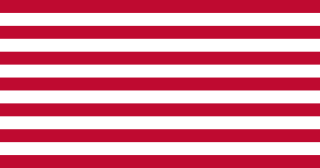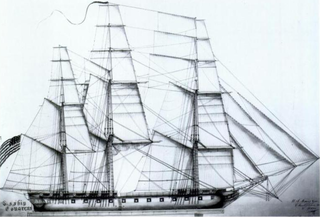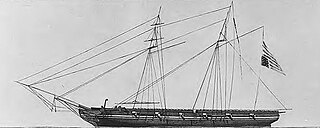Sources
- Dictionary of American History by James Truslow Adams, New York: Charles Scribner's Sons, 1940
- Dictionary of American Naval Fighting Ships , United States Navy, 1959
The Bergen Prizes were three British merchantmen (Betsy, Union, and Charming Polly) that were captured by Captain Pierre Landais of the USS Alliance and John Paul Jones of the USS Bonhomme Richard in 1779. Landais, who had had numerous disagreements with Jones over the command of the squadron in European waters, sent the vessels to Bergen, Norway. Once there, they were repaired and handed back to the British consul, depriving their captors of the satisfaction of having hurt the enemy and of any hope of being rewarded for their efforts.. However, the subject of indemnity was broached by Jones, who turned up in person at Copenhagen. Ultimately, no payment was made by the Danish government due to the existence of a treaty signed between the English and Danish governments in 1660 that obligated Denmark to England. As a result, no reward was given to the captains or crew of the United States vessels responsible for the capture of the merchantmen until the United States Congress ratified reimbursement to Landais in 1806 and the heirs of Jones in 1848.

John Paul Jones was a Scottish-American naval captain who was the United States' first well-known naval commander in the American Revolutionary War. He made many friends among U.S political elites, as well as enemies, and his actions in British waters during the Revolution earned him an international reputation which persists to this day. As such, he is sometimes referred to as the "Father of the American Navy".

The Quasi-War was an undeclared naval war fought from 1798 to 1800 between the United States and the French First Republic, primarily in the Caribbean and off the East Coast of the United States. The ability of Congress to authorize military action without a formal declaration of war was later confirmed by the Supreme Court and formed the basis of many similar actions since, including American participation in the Vietnam War and 1990 Gulf War.

The first Alliance of the United States Navy was a 36-gun sailing frigate of the American Revolutionary War.

USS Confederacy was a 36-gun sailing frigate of the Continental Navy in the American Revolutionary War. The British Royal Navy captured her in March 1781, took her into service for about half-a-year as HMS Confederate, and broke her up in 1782.

The Continental Navy was the navy of the United States during the American Revolutionary War, and was founded October 13, 1775. The fleet cumulatively became relatively substantial through the efforts of the Continental Navy's patron John Adams and vigorous Congressional support in the face of stiff opposition, when considering the limitations imposed upon the Patriot supply pool.

USS Wasp of the United States Navy was a sailing sloop-of-war captured by the British in the early months of the War of 1812. She was constructed in 1806 at the Washington Navy Yard, was commissioned sometime in 1807, Master Commandant John Smith in command. In 1812 she captured HMS Frolic, but was immediately herself captured. The British took her into service first as HMS Loup Cervier and then as HMS Peacock. She was lost, presumed foundered with all hands, in mid-1814.

Richard Dale was an American naval officer who fought in the Continental Navy under John Barry and was first lieutenant for John Paul Jones during the naval battle off of Flamborough Head, England against HMS Serapis in the celebrated engagement of September 23, 1779. He became one of the six original commodores of the permanent United States Navy, and commanded a blockade of Tripoli in 1801 during the First Barbary War of Thomas Jefferson's presidency.

Commodore Alexander Murray was an officer who served in the Continental Navy, the Continental Army, and later the United States Navy, during the American Revolutionary War, the Quasi-War with France and the First Barbary War in North Africa.

The Pacific Squadron was part of the United States Navy squadron stationed in the Pacific Ocean in the 19th and early 20th centuries. Initially with no United States ports in the Pacific, they operated out of storeships which provided naval supplies and purchased food and obtained water from local ports of call in the Hawaiian Islands and towns on the Pacific Coast. Throughout the history of the Pacific Squadron, American ships fought against several enemies. Over one-half of the United States Navy would be sent to join the Pacific Squadron during the Mexican–American War. During the American Civil War, the squadron was reduced in size when its vessels were reassigned to Atlantic duty. When the Civil War was over, the squadron was reinforced again until being disbanded just after the turn of the 20th century.

The Mediterranean Squadron, also known as the Mediterranean Station, was part of the United States Navy in the 19th century that operated in the Mediterranean Sea. It was formed in response to the First and Second Barbary Wars. Between 1801 and 1818, the squadron was composed of a series of rotating squadrons. Later, squadrons were sent in the 1820s to the 1860s to suppress piracy, primarily in Greece and to engage in gunboat diplomacy. In 1865 the force was renamed the European Squadron.
USS Nonsuch was a moderately successful privateer built in 1812 and then an armed schooner in the United States Navy during the War of 1812. She was sold for breaking up in 1826.

The capture of HMS Frolic was a naval action fought in the Atlantic on 18 October 1812, between the sloop-of-war USS Wasp, commanded by Master Commandant Jacob Jones, and the Cruizer-class brig-sloopHM Brig Frolic, under Commander Thomas Whinyates. The Americans captured the British vessel, but both vessels shortly thereafter captured by a British ship of the line which happened upon the scene of the battle.

HMS Egeria was a Royal Navy 26-gun Cormorant-class ship-sloop launched at Bridport in 1807. During the Gunboat War she captured three privateers and several merchant vessels. After the Napoleonic Wars she continued on active service until 1825, after which she served as a receiving or accommodation ship. She was eventually broken up in 1865.

The Battle of Flamborough Head was a naval battle that took place on 23 September 1779 in the North Sea off the coast of Yorkshire between a combined Franco-American squadron, led by Continental Navy officer John Paul Jones, and two British escort vessels protecting a large merchant convoy. It became one of the most celebrated naval actions of the war in America, despite its relatively small size and a considerable dispute over what had actually occurred.
HMS Ariel was a 20-gun Sphinx-class sixth-rate post ship of the Royal Navy. The French captured her in 1779, and she served during the American Revolutionary War for them, and later for the Americans, before reverting to French control. Her French crew scuttled Ariel in 1793 to prevent the British from recapturing her.

The West Indies Squadron, or the West Indies Station, was a United States Navy squadron that operated in the West Indies in the early nineteenth century. It was formed due to the need to suppress piracy in the Caribbean Sea, the Antilles and the Gulf of Mexico region of the Atlantic Ocean. This unit later engaged in the Second Seminole War until being combined with the Home Squadron in 1842. From 1822 to 1826 the squadron was based out of Saint Thomas Island until the Pensacola Naval Yard was constructed.

The West Indies Anti-Piracy Operations refer to the United States Navy presence in the Antilles, and surrounding waters, which fought against pirates. Between 1817 and 1825, the American West Indies Squadron constantly pursued pirates on sea and land, primarily around Cuba and Puerto Rico. After the capture of Roberto Cofresi in 1825, acts of piracy became rare, and the operation was considered a success, although limited occurrences went on until slightly after the start of the 20th century.

The Battle off Barbados was fought in March 1778 during the American Revolutionary War. While escorting a fleet of American ships in the West Indies, the frigate USS Randolph was attacked by the British ship-of-the-line HMS Yarmouth. The following action resulted in America's most costly naval defeat, in terms of human lives, until the sinking of USS Arizona in 1941.

The Callao affair occurred in November 1820, during the Peruvian War of Independence. It began when a Spanish fort opened fire on the United States warship USS Macedonian. Though the ship was damaged, the Americans did not violate their neutrality by counterattacking. On the following day, a boat filled with United States Navy sailors was attacked, resulting in the deaths of two seamen and the wounding of eight others. Two days after that, an American merchant ship was attacked and her crew had to abandon ship. Ultimately, there was no significant response by the United States to the attacks on their shipping and their citizens, though the Spanish government vowed to punish the perpetrators.